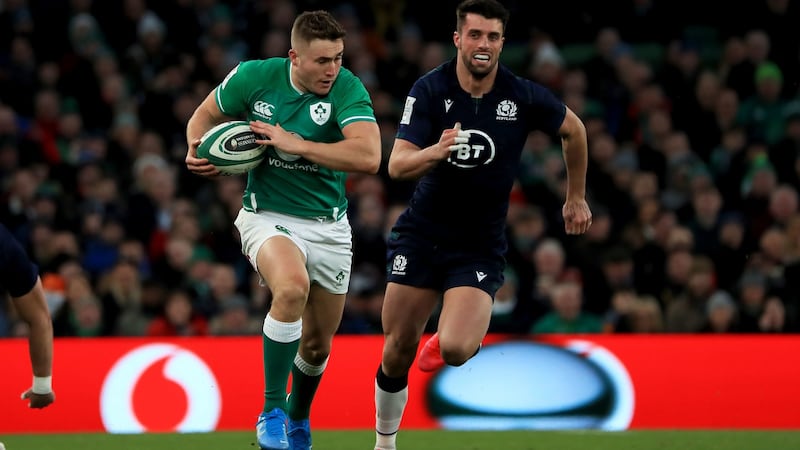I won’t lie. I went to the Aviva stadium on Saturday for one reason only: to watch Caelan Doris for 80 minutes.
Could his arrival open up the 70 metres of the pitch by mimicking what the All Blacks achieved with Kieran Read in combating the northern hemisphere blitz defence? By playing wider out, Read (and Doris) consistently opened up a blind side. And, with less defensive numbers, this would be impossible to blitz, allowing Jordan Larmour to flourish.
How would this reshaped backrow (I was equally excited for CJ Stander in the number six jersey) perform? Just as Doris and Stander were getting into their stride, though, the number eight had to depart, the backrow was reshuffled and my attention was immediately drawn elsewhere. Stander went on to win man of the match and Peter O’Mahony made a significant impact, but it became a sloppy match where Scotland conceded victory through errors, penalties and missed opportunities, with Ireland doing just enough.
Let’s ignore the “doing enough” and simply focus on the “doing”. Of the metres run by Ireland on Saturday, 75 per cent came through our centres and back three combined. Larmour alone accounted for 33 per cent of all Ireland’s metres made.
This is a huge jump from the past. Looking deeper into this trend, an interesting picture emerges. Yes, Ireland put boot to ball and Conor Murray was faithful to the box kick. From the very first kick-off reception Ireland moved off script and didn't exit through a "hold possession" of elaborate pods and carries before releasing downfield. Murray fielded and simply kicked the ball long and out of his 22.
"That's interesting," I thought. Yes, kicking is crucial, especially when John Cooney arrived and the game was in balance. He probed the corners with clever chip kicks that pinned the Scots back. And, off less possession, Ireland managed better field position.
Hunted
But what of Scotland's kicks? Every single time Larmour fielded them he hunted over the ground. It was often into traffic but, every time, he hunted and probed. This you'd expect from a player of his broken-field calibre – but that his team-mates were in tune was most satisfying. When was the last time you witnessed Garry Ringrose on the ball so often? And what impact did all this running have on the fixture?

Larmour ran an aggressive outside line, breaking the Scots, with Murray gliding along inside to receive the pass
Well, the lazy answer is a morbid win, but deeper analysis will alert us to a positive shift in attacking policy. Wales may come too quickly for this evolution, but there were signs that our outside backs were being unshackled. On 27 minutes Ringrose slid outside his man, heading towards the right-hand touchline in an effort to attract more defenders. Andrew Conway was alive to the play and hunted in off his wing. Ringrose got outside his man and swivelled a lovely inside pop pass to Conway. Absolutely nothing came off this play, but in time it will bear fruit.
Much earlier, on six minutes, Larmour ran an aggressive outside line, breaking the Scots, with Murray gliding along inside to receive the pass. Although Larmour’s break was not as a first receiver akin to the All Blacks attacking the blindside with an extra pivot, it was exactly what we want. Larmour, popping up on the soft, short side when the Scots couldn’t blitz. It set in motion a play that resulted in Ireland’s try.
By the way, what lovely sight, Cian Healy looking to barge over, selling it in fact, but pulling a wee pass out the back to Murray with Johnny Sexton running over. Lovely? Well it saved the Irish pack a million one out, one yard carries to eventually score. The scoreboard would look the same but the bodies not so. And Larmour's decoy line fixing Huw Jones to free Sexton! In other words, Jones was expecting Larmour to receive and defended thus. Try! Jacob Stockdale was also used on the blindside; further evidence of an attack policy.
Running
This change in running brought with it a worry. Scotland played way more of their possession in our half and 22 than we managed. In other words, much of the running of our back three was in the middle of the park. Scotland, by getting into our 22, created more pressure and, but for their sloppiness (Stuart Hogg/penalties/handling etc), they would have scored. But! The Irish defence was also magnificent in defending their white line and with this concerted effort ensured a home win. Defensive structures are “easier” than attacking structures and hence we must be patient as the latter evolves.
The scrum was also interesting, with Iain Henderson packing down as the tighthead secondrow. Why was this, as James Ryan was on the loosehead side. Small point? Well it's a shift in scrum policy, yet another insight into the new broom, this time with scrum coach John Fogarty. This platform was only used seven times, which is a marvellous nod towards the skill set of both sides, but I couldn't quite figure out referee Mathieu Raynal's interpretation of the Irish scrum.
What is success? Well a win is most helpful and Andy Farrell achieved that. But there is a subtle undercurrent of change and we must be patient as we are very vulnerable this weekend when facing Wales. Don't get too upset if the sloppiness continues but do watch the revel in the outside backs' running.
liamtoland@yahoo.com















